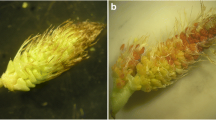Abstract
Investigations on the meiotic behaviour of chromosomes in interspecific hybrids (2n=6x=42) between Hordeum lechleri (6x) and H. procerum (6x) and in their component haploids have been utilized to assess the nature of pairing and the extent of genome homology between the two species. In the F1 hybrids an average of 25 (60%) chromosomes associated at metaphase I, mostly as bivalents. A majority (60%) of the pollen mother cells (PMCs) in H. procerum haploids (2n=3x=21) displayed 21 univalents and even in the remainder, a maximum of two rod bivalents were formed resulting in an average of 0.52 bivalents per cell. In haploids of H. lechleri (2n=3x=21) however, 30% of chromosomes pair. The sum of the chromosomal associations in the component haploids represents only 17% of the complement, far below the observed frequency (60%) in the hybrids. Thus, the pairing displayed in hybrids between H. lechleri and H. procerum was mostly allosyndetic and suggestive of two genomes being common in these species.
In haploid H. procerum 1/3 of the PMCs displayed a tripolar organisation of chromosomes leading to triad and hexad formation after divisions I and II respectively. The significance of hexad formation in the trihaploid H. procerum and a possible suppression of homoeologous pairing in H. procerum haploids are discussed.
Similar content being viewed by others
References
Collins, G. B. & Sadasivalah, R. S., 1972. Melotic analysis of haploid and doubled haploid forms of Nicotiana otophora and N. tabacum. Chromosoma 38: 387–404.
Gauthier, F. M. & McGinnis, R. C., 1968. The melotic behaviour of a nullihaploid plant in Avena setiva L. Can. J. Genet. Cytol. 10: 186–189.
Jauhar, P. P., 1975. Genetic control of diploid like melosis in hexaploid tall fescue. Nature (Lond.) 354: 595–597.
Kasha, K. J., Subrahmanyam, N. C. & All, A., 1978. Effect of gibberellic acid treatment, and nutrient supply through detached tillers, upon haploid frequency in harley. Theor. appl. Genet. 51: 169–175.
Manga, V. & Pantulu, J. V., 1971. The miiotic behaviour of a haploid Pearl millet. Genetica 42: 319–328.
Miller, T. E. & Chapman, V., 1976. Aneuhaploids in bread wheat. Genet. Res. (Camb.) 28: 37–45.
Nishiyama, I. & Tabata, M., 1964. Cytogenetic studies in Avena XII. Meiotic chromosome behaviour in a haploid cultivated oat. Jap. J. Genet. 38: 311–316.
Rajhathy, T. & Morrison, J. W., 1959. Cytogenetic studies in genus Hordeum IV. Hybrids of H. jubatum, H. brachyantherum, H. vulgare and a hexaploid Hordeum species. Can. J. Genet. Cytol. 1: 124–132.
Rajhathy, T. & Morrison, J. W., 1961. Cytogenetic studies in the genus Hordeum V. H. jubatum and the New World species. Can. J. Genet. Cytol. 3: 378–390.
Rajhathy, T., Morrison, J. W. & Symko, S., 1963. Interspecific and intergeneric hybrids in Hordeum. Barley Genetics I: 195–213.
Rajhathy, T. & Symko, S., 1974. High frequency of haploids from cross of Hordeum lechleri (6x)×H. vulgare (2x) and H. jubatum (4x)×H. bulbosum (2x). Canad. J. Genet. Cytol. 16: 468–472.
Rajhathy, T. & Thomas, H., 1972. Genetic control of chromosome pairing in hexaploid oats. Nature New Biol. (Lond.) 239: 217–219.
Riley, R., 1960. The diploidization of polyploid wheat. Heredity 15: 407–429.
Riley, R. & Chapman, V., 1958. Genetic control of the cytologically diploid behaviour of hexaploid wheat. Nature (Lond.) 182: 713–715.
Sadasivaiah, R. S. & Kasha, K. J., 1971. Meiosis in haploid barley. An interpretation of non-homologous chromosome associations. Chromosoma 35: 247–263.
Sadasivaiah, R. S. & Kasha, K. J., 1973. Non-homologous associations of haploid barley chromosomes in the cytoplasm of Hordeum bulbosum L. Can. J. Genet. Cytol. 15: 45–52.
Sears, E. R. & Okamoto, M., 1957. Genetic and structural relationships of non homologous chromosomes in wheat. Proc. int. Genet. Symp. 1956, Suppl. Vol. Cytologia 332–335.
Snow, R., 1963. Alcoholic hydrochloric acid carmine as a stain for chromosome squash preparations. Stain Technol. 38: 9–13.
Subrahmanyam, N. C., 1977. Haploidy from Hordeum interspecific crosses I. Polyhaploids of H. parodii and H. procerum. Theor. appl. Genet. 49: 209–217.
Subrahmanyam, N. C., 1978. Meiosis in polyhaploid Hordeum: Hemizygous ineffective control of diploid-like behaviour in a hexaploid? Chromosoma 66: 185–192.
Author information
Authors and Affiliations
Rights and permissions
About this article
Cite this article
Reddy, M.K., Subrahmanyam, N.C. Genome relationships between Hordeum procerum (6x) and H. lechleri (6x). Genetica 66, 53–61 (1985). https://doi.org/10.1007/BF00123605
Received:
Accepted:
Issue Date:
DOI: https://doi.org/10.1007/BF00123605




